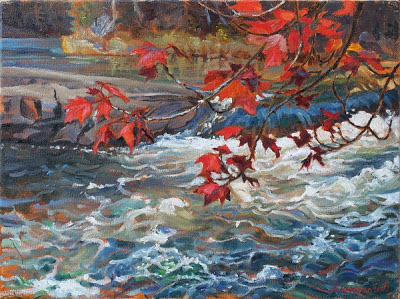Icicles and Crayfish
Here is another view from the studio window, on February 16, interrupting me with breathtaking crystal wedding of ice and sky as I laboured with watercolour details of a crayfish. ....yes, the top photo is flipped vertically to join the horizontals.
And here is a fairy fantasy detail of the tips....
Now I'll show you the scene of my painting. The crayfish Orconectes limosus, an immigrant to Quebec from the northeastern US, is making progress westward in the St. Lawrence River toward Ontario. This is the final watercolour of my series of 10 Ontario crayfish species, originally painted for the fishing bait identification book, "The Essential Bait Guide" and now being used in a crayfish identification guide to be published this spring by the Toronto Zoo. Fred and I have designed the layout, and will soon finish editing the penultimate draft. You can see the poster I designed a couple of years ago, propped up on the left as a comparative reference for my work.
Jean-Francois Desroches sent me a photo that he took of O. limosus alive in an aquarium. I was very pleased to get this side-view, as it is a comparable 'side view' to my paintings of the other species.
Then we received several preserved specimens in the mail. They had been taken by Parks Canada personnel from a newly introduced population on Cape Breton Island -- in a province that has no native Crayfish. Don McAlpine mailed them to us, as he said "preserved lightly in formalin". I selected one to paint and immersed it in water, in the same little viewing tank that I used to paint living examples of all the other species.
In order to spread the tail in the right position, and lower the claw so that the diagnostic spines on the side of its head can be seen, I tied the specimen down with thread to a rectangle of hardware cloth. It looks rather like an invertebrate Gulliver, captured by the Lilliputians, doesn't it? I have a fishhook holding the antenna at the correct angle. I would rather paint a live crayfish, but I must admit, this one stayed most wonderfully still, for looking so alive! We are amazed at how the colour was so perfectly preserved. It looks so like the photo that was sent to me of a live one in an aquarium.
So here, finally, is the watercolour - and as soon as I insert the image into its spot in the layout, I'll turn to drawing a labelled anatomy to help explain the body parts referred to in the species descriptions, while Fred edits the text according to the helpful comments contributed by our "Project Crayfish" group.



Nice that Nature calls to you through your window! Your watercolours are worth the time spent indoors though... that hardware cloth creates a handy reference grid as well as a tether!
ReplyDeleteThat's the first time I've used a hardware cloth grid. It may prove handy for anchoring and positioning other kinds of subjects, both under water and out. It always gives me a feeling of satisfaction to invent something like that!
ReplyDeleteNeat post and photos, Aleta. I've seen some of your previous crayfish paintings, and am looking forward to seeing your paintings in the Toronto Zoo publication this spring. I hope you'll post some info on how to obtain a copy once it's available!
ReplyDelete